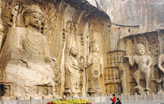Prime
Urbanization 'threatens food security'
Updated: 2011-03-28 07:59
By Chen Xin (China Daily)
BEIJING - Blind and excessive land exploitation in China's urbanization may partially contribute to the sharp decrease of the country's arable land and pose a threat to food security, a senior official has warned.
"We should not excessively turn farmland into urban areas. Grain security should be given priority," Yang Weimin, secretary-general of the National Development and Reform Commission, the top economic planning body, said at a forum about urbanization strategy and planning over the weekend.
Yang said the country has approved more than 1,500 national- and provincial-level industrial development zones, the area of which account for nearly 1 million hectares.
"But not all places need to massively boost industrialization and urbanization. For example, we should leave major agricultural and ecological areas as they are and limit their urbanization," he said.
Newly built urban areas in China had grown by 50 percent since 2000, while the urban population increase by only 26 percent during the same period, Yang said, which means the country's speed in urbanizing land almost doubles the rate for the urbanization of the population.
Chen Xiwen, director of the office for the Communist Party of China Central Committee's Leading Group on Rural Work, said last week that China's arable land had declined by 8.3 million hectares in the past 12 years partly as a result of the country's urbanization.
However, Chen said the pursuit of high urbanization was unnecessary and that ensuring balanced urbanization and rural development, and the development of both big and small cities, was more important.
City clusters, which have proven successful in countries such as Canada, Australia and Japan, could be effectively adopted in China's urbanization, he said.
Each city in a cluster would have its unique function and develop specific industries. Better public services and residential functions in small cities and towns, and a more unified infrastructure network linking the big and small cities would help form an efficient city cluster.
The big cities could also transfer some of their functions to neighboring small and medium cities, to relieve the pressure brought by the growing population, he added.
Beijing plans to boost the scale and density of industries in its suburban areas, neighboring Tianjin municipality and cities in Hebei province, according to the capital's draft 12th Five-Year Plan (2011-2015).
Downtown Beijing absorbs 62 percent of the city's population and produces 70 percent of its GDP, which has caused problems such as worsening traffic congestion, said Zhao Hong, an economist with Beijing Academy of Social Sciences.
Transferring the capital's industries such as manufacturing and logistics to neighboring areas will not only help form a more functional Beijing-centered city cluster, but also realize a population transfer, Zhao was quoted by the Beijing News as saying.
China Daily
Specials

Tea-ing up
More turning to Chinese tea for investment opportunities like vintage wine

A cut above
The ancient city of Luoyang is home to a treasure trove of cultural wonders.

Rise and shine
The Chinese solar energy industry is heating up following recent setbacks in the nuclear sector